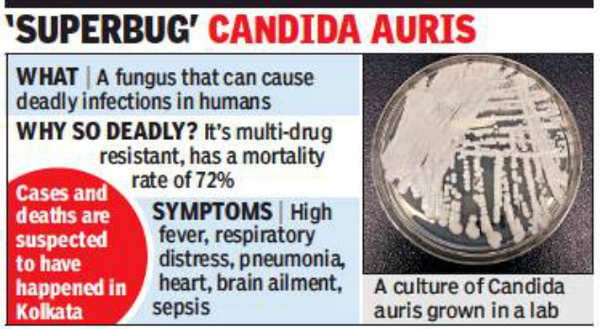- News
- City News
- kolkata News
- Kolkata hospitals sound alarm over drug-resistant fungus
Trending
This story is from April 12, 2019
Kolkata hospitals sound alarm over drug-resistant fungus

Representative image
KOLKATA: Some Kolkata hospitals have sounded the alert about a deadly fungus that’s on the prowl across India and neighbouring countries, apart from North America, Europe and Australia. Candida auris (C auris) is multi-drug resistant, strikes those with low immunity and has a mortality rate of up to 72%. Doctors in Kolkata say they have encountered the fungus, which has triggered deaths.
Infections are rare, but an outbreak could be very difficult to contain, as few hospitals in the city can detect it.Doctors suspect there are already a large number of undetected cases in the country.

At least two private hospitals in the city have alerted their consultants about the threat and asked them to identify suspected patients.
C auris grows in the bloodstream or internal organs and multiplies exponentially, especially in patients with low immunity. “Diabetics, those with kidney, lung, cardiac ailments and cancer patients are vulnerable, along with children and the elderly. The first symptom is fever and it’s usually followed by breathing distress, pneumonia, heart or brain ailments and sepsis,” said consultant Arindam Biswas.
Both C auris and C albicans are often found in body cavities like the mouth, nose and vagina. “Generally, they remain harmless till the carrier starts suffering from low immunity. Once C auris multiplies and infiltrates the bloodstream, it’s risky,” said Saha.
Patients invariably catch the germ in hospitals. According to a private hospital consultant, the fungus was endemic in some hospitals and a spread is a constant threat. “There is little that can be done to prevent a spread, other than being alert and prompt with treatment,” he said.
C auris rarely spreads from the community, according to Medica Superspecialty Hospital microbiologist Aviral Ray. “Rampant and non-judicious use of high-end antibiotics is a risk. Once an individual gets resistant to antibiotics, he or she is likely to remain in hospital for a longer period, leading to a higher chance of contracting the fungus. The fact that C auris is drug-resistant makes it more dangerous,” said Ray. He added that laboratory equipment needed to identify the fungus were hardly available in India. “We probably have a large number of undetected cases and the threat is bigger than what we perceive it to be.”
Infections are rare, but an outbreak could be very difficult to contain, as few hospitals in the city can detect it.Doctors suspect there are already a large number of undetected cases in the country.

At least two private hospitals in the city have alerted their consultants about the threat and asked them to identify suspected patients.
Even though not as common as Candida albicans — a pathogenic yeast that has been invading Kolkata hospitals in recent years — C auris has been striking intermittently. “Fungal infections are detected late, which delays treatment,” said Apollo Gleneagles Hospital consultant Shyamasis Bandopadhyay. “C auris is deadly, since it is multi-drug resistant. Over the last six-seven years, I have come across several C auris patients, of whom around half didn’t survive.” The fungus triggers fever, which refuses to go for weeks, low blood pressure, a rapid pulse, respiratory distress and low urine formation. In such cases, the protocol is to use antibiotics and wait for 48 hours. “If the
fever doesn’t go, a blood sample has to be sent for fungal culture to detect infection. Once detected, anti-fungal drugs need to be administered intravenously. Even if no fungus is detected, it is safe to use the anti-fungal drugs empirically,” said AMRI Hospital consultant Debashish Saha, adding that Candida albicans was more common in Kolkata. “Both are fungi but C auris is resistant to common drugs, which makes it difficult to control.”
C auris grows in the bloodstream or internal organs and multiplies exponentially, especially in patients with low immunity. “Diabetics, those with kidney, lung, cardiac ailments and cancer patients are vulnerable, along with children and the elderly. The first symptom is fever and it’s usually followed by breathing distress, pneumonia, heart or brain ailments and sepsis,” said consultant Arindam Biswas.
Both C auris and C albicans are often found in body cavities like the mouth, nose and vagina. “Generally, they remain harmless till the carrier starts suffering from low immunity. Once C auris multiplies and infiltrates the bloodstream, it’s risky,” said Saha.
Patients invariably catch the germ in hospitals. According to a private hospital consultant, the fungus was endemic in some hospitals and a spread is a constant threat. “There is little that can be done to prevent a spread, other than being alert and prompt with treatment,” he said.
C auris rarely spreads from the community, according to Medica Superspecialty Hospital microbiologist Aviral Ray. “Rampant and non-judicious use of high-end antibiotics is a risk. Once an individual gets resistant to antibiotics, he or she is likely to remain in hospital for a longer period, leading to a higher chance of contracting the fungus. The fact that C auris is drug-resistant makes it more dangerous,” said Ray. He added that laboratory equipment needed to identify the fungus were hardly available in India. “We probably have a large number of undetected cases and the threat is bigger than what we perceive it to be.”
End of Article
FOLLOW US ON SOCIAL MEDIA










